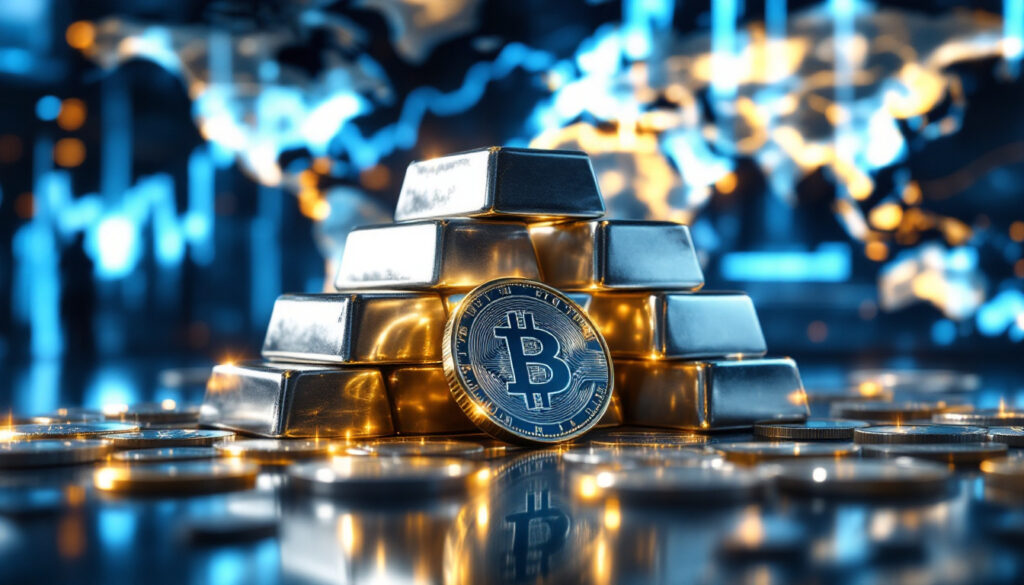What is the Silver Squeeze 2.0?
The "Silver Squeeze" movement represents a coordinated effort by retail investors to influence silver prices through concentrated buying of physical silver and silver-related investments. The silver squeeze 2.0 is the latest iteration of this movement, following the initial attempt in February 2021 that created temporary market disruptions but fell short of achieving lasting price impacts.
Understanding the Silver Squeeze Movement
At its core, the Silver Squeeze aims to expose what many participants believe is manipulation in the silver market by large financial institutions. The theory suggests that by removing physical silver from the market through collective purchasing, investors can force a price discovery mechanism that reflects true supply-demand fundamentals.
According to precious metals analyst John Rubino, "What we're seeing now is a growing awareness that silver is perhaps the most undervalued asset in the financial world, with a market structure that makes it uniquely vulnerable to supply shortages."
Key Differences Between Silver Squeeze 1.0 and 2.0
The current Silver Squeeze 2.0 differs from its predecessor in several important aspects:
- Increased market sophistication: Retail investors demonstrate greater understanding of silver market mechanics, including the distinction between paper and physical markets.
- Improved physical market conditions: There's more physical silver available in dealer inventories compared to the acute shortages of 2021.
- Strategic approach: Rather than one-day buying events, the movement has evolved toward sustained accumulation strategies.
- Realistic expectations: Participants now recognize that meaningful price changes require persistent pressure rather than short-term campaigns.
What Factors Are Driving Silver Price Predictions?
The current bullish case for silver rests on a convergence of supply-demand fundamentals, monetary policy consequences, and market structure characteristics that could potentially create significant price pressure.
The Bullish Case for Silver
Silver presents a compelling value proposition based on several metrics:
- Gold-to-silver ratio imbalance: Historically averaging around 40:1, the ratio has remained elevated above 80:1 in recent years, suggesting silver is undervalued relative to gold.
- Dual-demand nature: Unlike gold, silver faces pressure from both industrial applications and investment demand.
- Physical market tightness: Industry reports indicate that COMEX silver inventories have declined significantly, with registered silver stocks falling to multi-year lows.
- Mining supply constraints: Primary silver mines represent only 28% of global production, with most silver sourced as a byproduct of other metal mining operations.
Economic Factors Supporting Higher Silver Prices
The macroeconomic backdrop provides additional support for potential silver price appreciation:
- Expansionary monetary policies: Central banks continue accommodative policies that historically benefit precious metals market trends analysis.
- Record sovereign debt levels: U.S. national debt exceeding $33 trillion creates currency debasement concerns.
- De-dollarization trends: BRICS nations and others are reducing dollar dependency, potentially increasing precious metals demand.
- Inflation persistence: Despite official moderation, real-world inflation remains elevated, enhancing silver's appeal as a store of value.
According to a recent industry analysis, "Silver's industrial demand is projected to increase by 5-7% annually through 2025, driven by solar panel production, electric vehicles, and electronics manufacturing—creating unprecedented pressure on available supplies."
How High Could Silver Prices Go?
Expert Price Projections
Industry analysts offer varying perspectives on silver's price potential:
- Conservative estimates: Project $36-40 per ounce by end of 2023, representing a moderate 30-45% increase from current levels.
- Moderate bullish forecasts: Suggest $50-75 per ounce within the next 18-24 months if industrial demand continues accelerating.
- Extreme scenarios: Some analysts point to three-digit price possibilities ($100+) in cases of severe supply shortages or financial system stress.
The most intriguing perspective comes from metals analyst John Rubino, who notes: "At some point, silver could transition from being price-sensitive to availability-sensitive, where obtaining physical metal becomes more important than the nominal cost."
Historical Context for Silver Price Movements
Silver's price history provides important context for current projections:
- 1970s bull market: Silver rose from $1.50 to $50 between 1971-1980, a 3,200% increase.
- 2008-2011 rally: Following the financial crisis, silver surged from $9 to nearly $50, a 450% gain.
- Cyclical patterns: Precious metals bull markets typically see gold rise first, followed by explosive silver price movements with greater percentage gains.
- Gold-silver ratio compression: Previous bull markets ended with ratios falling to 30:1 or lower, suggesting significant silver outperformance potential if historical investment trends repeat.
Why Is Silver Market Structure Important?
Understanding Silver Market Dynamics
Silver's unique market structure creates vulnerabilities not present in most commodity markets:
- Size disparity: The physical silver market is remarkably small (approximately $30 billion annually) relative to financial markets.
- Paper leverage: For every ounce of physical silver, estimates suggest 250-500 ounces exist in paper form through derivatives and unallocated accounts.
- Limited investment availability: Only 15-25% of annual silver production becomes available for investment in bullion form.
- Delivery bottlenecks: Refineries and mints operate with limited excess capacity, creating potential choke points during demand surges.
A metals industry consultant explains, "The silver market is akin to an elephant trying to pass through a garden hose—the market structure simply can't accommodate sudden large-scale physical demand without significant price dislocations."
The Manipulation Debate
The silver market has long been surrounded by controversy regarding potential price suppression:
- Historical precedent: The Hunt brothers' attempt to corner the silver market in 1980 led to regulatory changes specifically targeting silver.
- CFTC investigations: Multiple investigations into silver market manipulation have occurred, with mixed findings.
- Concentrated short positions: Unusually large short positions are consistently held by a small number of financial institutions.
- Disconnect between paper and physical markets: During supply stress, physical premiums expand significantly above spot prices, indicating market inefficiencies.
Market analyst Ted Butler, who has studied silver for decades, contends: "The concentrated short position in COMEX silver futures held by a handful of banks remains the single most important factor in silver price formation, more significant than industrial demand or mining supply."
What's the Smart Approach to Silver Investing?
Dollar-Cost Averaging Strategy
Financial experts recommend a measured approach to silver acquisition:
- Systematic purchasing: Rather than attempting to time market bottoms, allocate a fixed amount to silver purchases at regular intervals.
- Premium awareness: During supply disruptions, physical silver premiums can significantly increase—adjust purchase timing when possible to minimize premium costs.
- Size diversification: Balance holdings between different sizes (1oz coins vs. larger bars) to maximize liquidity and minimize premiums.
- Quality considerations: Stick with recognized sovereign mints and established private minters to ensure quality and resalability.
Long-Term Holding vs. Short-Term Trading
Investment timeframe significantly impacts silver strategy:
- Long-term preservation: Physical silver serves primarily as wealth insurance against monetary system disruptions.
- Volatility tolerance: Silver typically experiences 30-50% pullbacks even during bull markets—psychological preparation is essential.
- Generational perspective: Historical performance demonstrates silver's ability to maintain purchasing power over decades despite significant interim volatility.
- Trading challenges: Silver's price volatility makes it extremely difficult to trade profitably—most traders underperform simple buy-and-hold strategies.
As veteran precious metals advisor David Morgan often states, "Buy silver when you have money, not when you need money. The goal is to convert paper assets to hard assets systematically over time."
How Does Silver Fit Into a Broader Preparedness Strategy?
Beyond Investment: Silver as Financial Insurance
Silver's role extends beyond pure investment considerations:
- Historical monetary role: For thousands of years, silver functioned as everyday spending money across civilizations.
- Divisibility advantage: Silver's lower value per ounce compared to gold makes it practical for smaller transactions.
- Recognizability: Silver coins and small bars are widely recognized and relatively difficult to counterfeit.
- Non-systemic wealth: Physical silver exists outside the banking system, providing financial resilience during institutional stress.
Comprehensive Preparedness Considerations
A balanced approach to preparedness includes:
- Essential supplies priority: Secure food, water, medical supplies, and energy backups before significant precious metals allocation.
- Liquidity balance: Maintain sufficient cash reserves for immediate needs before converting to precious metals.
- Storage security: Implement proper secure storage solutions, potentially across multiple locations.
- Asset class diversification: Balance silver holdings with other global commodities market insights and traditional investments.
Industry expert Lynette Zang advises, "Silver should be viewed as part of a comprehensive wealth preservation strategy, not as a speculative vehicle. It's financial insurance first, with appreciation potential as a secondary benefit."
FAQs About the Silver Squeeze Movement
Will Coordinated Buying Actually Impact Silver Prices?
While one-day buying events create temporary pressure, lasting price impacts require:
- Sustained pressure: Consistent physical accumulation over extended periods
- Industrial demand competition: Investor buying must compete with manufacturing needs
- COMEX delivery requests: Increased standing for delivery on futures contracts
- ETF transparency improvements: Pressure on silver ETFs to demonstrate adequate backing
How Does the Gold-to-Silver Ratio Affect Investment Decisions?
The gold-silver ratio serves as a valuable strategic indicator:
- Mean reversion potential: The current elevated ratio (80+:1) compared to historical averages (40:1) suggests silver may outperform gold
- Switching strategies: Some investors convert between metals based on ratio extremes
- Industrial factor: Unlike gold, silver's industrial demand creates a fundamentally different supply-demand dynamic
- Correlation variations: During financial stress, silver can initially decline with industrial commodities before monetary characteristics dominate
According to a recent gold and silver market recap, the shifting ratio between these two metals can provide important signals for investors about potential market trends.
What Are the Warning Signs of a Major Silver Price Movement?
Key indicators that may precede significant price appreciation include:
- Physical premiums expansion: Retail premiums exceeding 30% above spot prices
- Delivery delays: Major dealers extending shipping timeframes beyond 2-3 weeks
- Inventory depletion: Visible drawdowns in COMEX registered silver categories
- Industrial user behavior: Manufacturers securing long-term supply contracts or building inventories
- Institutional participation: Evidence of pension funds or sovereign wealth funds adding allocation
For a deeper understanding of how regulatory policies impact commodity markets, investors should consider how changes in government approaches affect silver pricing.
How Much of My Portfolio Should Be Allocated to Silver?
Allocation considerations vary widely based on:
- Financial situation: Those with substantial fixed expenses should prioritize liquidity
- Age and time horizon: Younger investors can typically allocate higher percentages to volatile assets
- Existing assets: Balance silver with other tangible assets and income-producing investments
- Systemic risk assessment: Higher allocations may be appropriate for those concerned about monetary system stability
Most conservative financial advisors suggest limiting precious metals to 5-15% of investable assets, though those focused on system fragility often recommend up to 25-30%.
For retail investors looking to participate in the silver squeeze movement, Stockhead's analysis on maintaining a level head during market volatility provides valuable perspective. Furthermore, for those tracking the market's response to coordinated buying events, Kitco's coverage of silver price technical breakouts offers essential market insights.
Ready to Stay Ahead of the Next Major Mineral Discovery?
Don't miss potential silver market opportunities—subscribe to Discovery Alert's real-time notification service to identify significant mineral discoveries across the ASX as they happen. Visit our discoveries page to understand how transformative mineral announcements can generate substantial returns, all powered by our proprietary Discovery IQ model.




